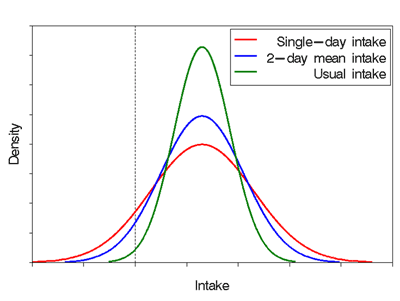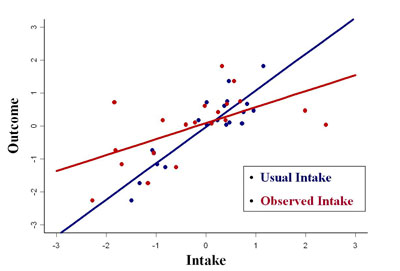This limitation -- excessive intra-individual variation -- can lead to serious problems in data interpretation. For example, the distribution of single-day intakes has a larger variance than the true usual intake distribution. This means using a single day’s intake -- or even the average of two -- would lead to a biased estimate of the fraction of the population with usual intake above or below some standard.

Figure 1: Bell curve containing sample data. The x-axis is labelled "Intake" and the y-axis is "Density". There are three lines. "Single-day intake" is the shortest and widest. "2-day mean intake" is somewhat narrower and taller. "Usual intake" is the narrowest and tallest. A dotted vertical line appears two-sevenths of the way in from the left edge of the chart.
Another problem relates to the interpretation of regression analyses in examining diet-disease relationships. The excessive intra-individual variation inherent in single day intakes is a type of measurement error. All types of dietary measurement error will generally lead to biased estimation and a loss of statistical power, and may invalidate statistical tests used in regression analyses.

Figure 2: Scatterplot containing sample data. The x-axis is labelled "Intake" and the y-axis is "Outcome". Data points in two colors represent "Usual Intake" and "Observed Intake". A line drawn through the "Usual Intake" points rises from about (-2.9, -3.2) to about (3.1, 3.1). A line drawn through the "Observed Intake" points rises less sharply, from about (-3.0, -1.3) to about (3.1, 1.2).
Fortunately, statistical modeling can be used to mitigate this limitation of 24-hour recalls. NCI has developed a method of assessing long-term average, or "usual," dietary intake that builds on the strengths of 24-hour recalls and can employ food frequency questionnaires when applicable. This research has the potential for advancing our methodological work, and has implications for our work in food guidance and policy. An improved sense of what people really are eating will help in formulating targeted recommendations and evaluating progress toward national health objectives.